#wool carder bee
Text

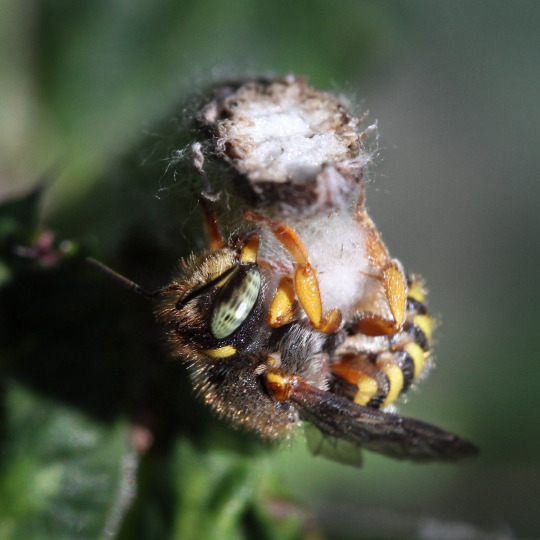



An Oblong Woolcarder Bee "carding wool," or gathering plant fibers to line her nest. She pulls fibers from the plant and holds them in a ball against her abdomen, and then, with some calisthenics, tightens up the ball before flying off with it in her mandibles.
Oblong Woolcarder Bee (Anthidium oblongatum)
July 15, 2023
Southeastern Pennsylvania
#bee#bees#photographers on tumblr#bugs#bug#Anthidium oblongatum#wool carder bee#woolcarder bee#bugblr#entomology#insects#insect#hymenoptera#oblong woolcarder#beeblr
776 notes
·
View notes
Text
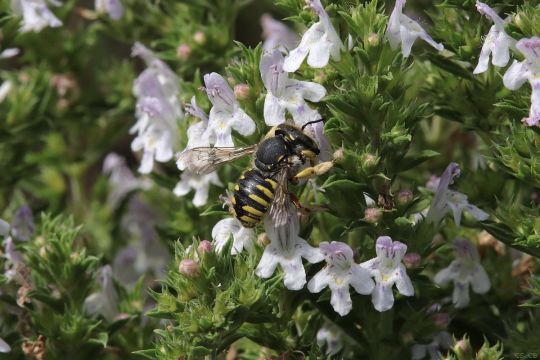
#Wollbiene#Winterbohnenkraut#European wool carder bee#Anthidium manicatum#Winter savory#Wild Life Germany
9 notes
·
View notes
Text
I've officially recognized three kinds of native bees visiting my wildflower mixes; leaf cutter bees, cellophane bees, and now carder bees. I am absolutely thrilled. This is exactly what I wanted when I planted these flowers and I'm so glad to know that so many of our least appreciated bees are benefiting from my work.
My squash is also starting to form flowers so hopefully we'll be getting some squash bees too :)
4 notes
·
View notes
Text
Wool-Carder Bees: these solitary bees harvest the soft, downy hairs that grow on certain plants, rolling them into bundles and then using the material to line their nests

Wool-carder bees build their nests in existing cavities, usually finding a hole/crevice in a tree, a plant stem, a piece of rotting wood, or a man-made structure, and then lining the cavity with woolly plant fibers, which are used to form a series of brood cells.
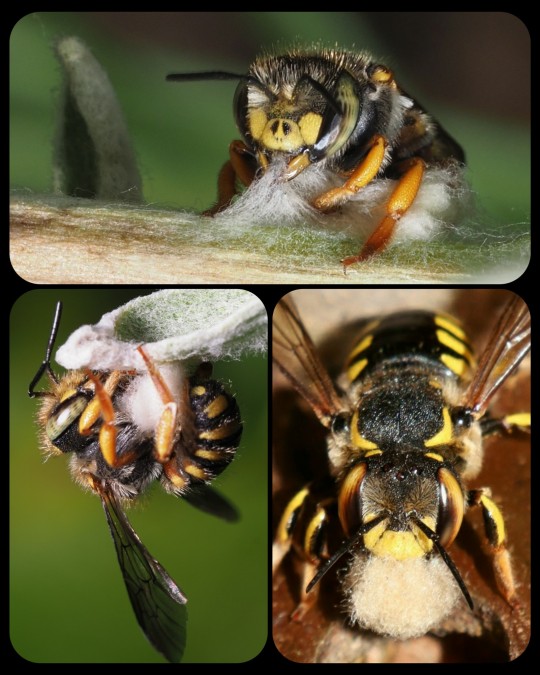
The fibers (known as trichomes) are collected from the leaves and stems of various plants, including lamb’s ear (Stachys byzantina), mulleins, globe thistle, rose campion, and other fuzzy plants.

From the University of Florida's Department of Entomology & Nematology:
The female uses her toothed mandibles to scrape trichomes off fuzzy plants and collects a ball of the material under her abdomen. She transports these soft plant fibers to her selected nest site and uses them to line a brood cell. Next, she collects and deposits a provision of pollen and nectar into the cell, enough pollen to feed a larva until it is ready to pupate. Lastly, she lays a single egg on top of the pollen and nectar supply before sealing the cell. ... She will repeat this process with adjoining cells until the cavity is full.
These are solitary bees, meaning that they do not form colonies or live together in hives. Each female builds her own nest, and the males do not have nests at all.
Female wool-carder bees will sometimes sting if their nest is threatened, but they are generally docile. The males are notoriously aggressive, however; they will often chase, head-butt, and/or wrestle any other insect that invades their territory, and they may defend their territory from intruders up to 70 times per hour. The males do not have stingers, but there are five tiny spikes located on the last segment of their abdomen, and they often use those spikes when fighting. They also have strong, sharp mandibles that can crush other bees.
There are many different types of wool-carder bee, but the most prolific is the European wool-carder (Anthidium manicatum), which is native to Europe, Asia, and North Africa, but has also become established as an invasive species throughout much of North America, most of South America, and New Zealand. It is the most widely distributed unmanaged bee in the world.
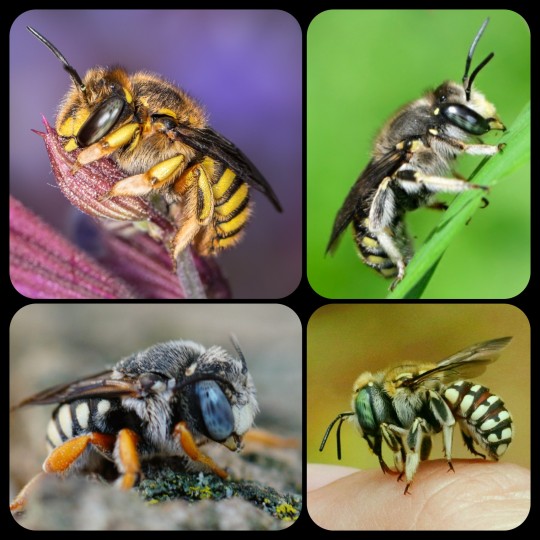
A few different species of wool-carder bee: the top row depicts the European wool-carder, A. manicatum (left) and the spotted wool-carder, Anthidium maculosum (right), while the bottom row depicts the reticulated small-woolcarder, Pseudoanthidium reticulatum, and Porter's wool-carder, Anthidium porterae
Sources & More Info:
University of Florida: The Woolcarder Bee
Oregon State University: European Woolcarder Bees
Bohart Museum of Entomology: Facts about the Wool Carder Bee (PDF)
Bumblebee Conservation Trust: A. manicatum
World's Best Gardening Blog: European Wool Carder Bees - Likeable Bullies
Biological Invasions: Global Invasion by Anthidium manicatum
#entomology#hymenoptera#apiology#melittology#bees#woolcarder bees#nature#insects#arthropods#science#solitary bees#european woolcarder#anthidium#animal facts#cool bugs#cute animals
712 notes
·
View notes
Photo
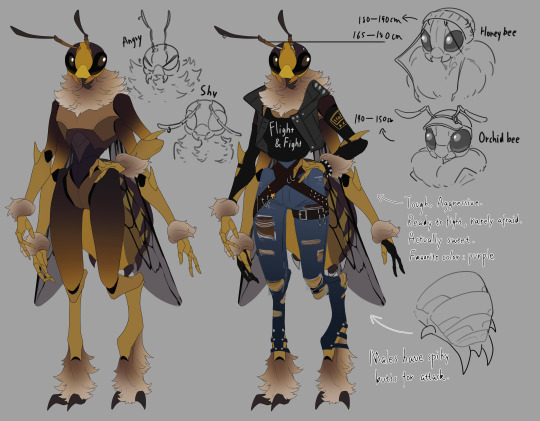

New bee alien inspired by wool carder bees
1K notes
·
View notes
Text

Apiary April - Wool Carder Bee
389 notes
·
View notes
Text
November 5th, 2023


Wool Carder Bee (Anthidium manicatum)
Distribution: Native to Europe, Asia and North Africa; introduced to South America, North America, New Zealand and the Canary Islands, where it's invasive.
Habitat: Normally found in gardens, fields and meadows that contain their preferred plants, but also found in heathlands, woodland rides and clearings, wetlands, river banks,
Diet: Generalists; feed on the pollen from various flower families, with a preference for species found in their native distribution; prefer blue flowers with long throats.
Description: The wool carder bee earns its name from its behaviour of scraping the trichomes (or hairs) from the leaves of plants, creating little balls of hair that they use to line their nests, built into pre-existing cavities such as hollow stems and dead wood. Other materials used in nest-building include mud, resin, stones and leaves. The trichome bundles are fashioned into little cells, in which the female will lay an egg, along with a bundle of pollen and nectar for the larva to feed on after it hatches. Once all the cells are full, the cavity is sealed off with a terminal plug.
Male wool carder bees are extremely territorial and aggressive, both to other males of their species as well as other pollinators. This has two purposes: first of all, the male defends its ressources, which allows it to have ample food for itself, but a food-filled territory also attracts females for the males to mate with. When an uninvited guest comes to feed on a flower in the male's territory, the male will attack it with brief, aggressive tackles in order to shoo it away. If this isn't enough, the male will occasionally crush the enemy to death against its spiky abdomen (because this bee does not have a stinger!).
Here's a really cool video of a female wool carder bee harvesting trichomes!
(Images by Bruce Marlin and Pierre Bornand)
70 notes
·
View notes
Text


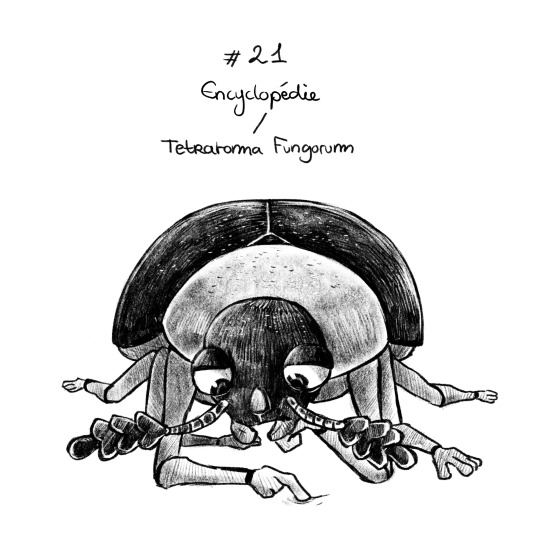

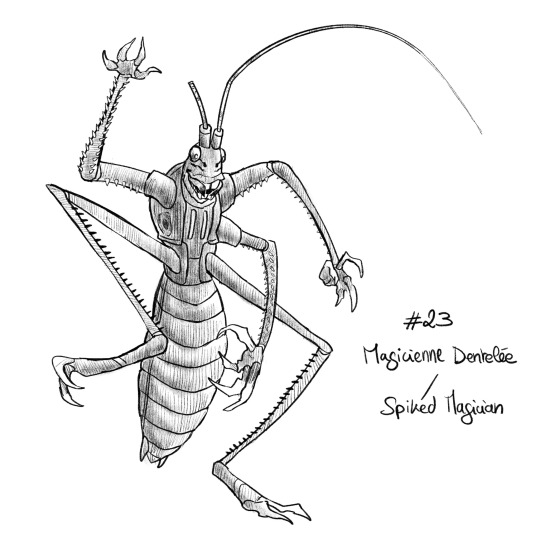
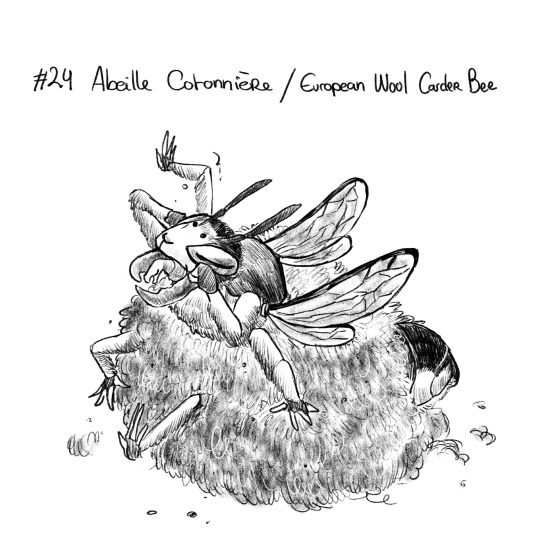
Day 19: Lappet
Day 20: Pygmy Damselfly
Day 21: Tetratoma Fungorum
Day 22: Booklice
Day 23: Spiked Magician
Day 24: European Wool Carder Bee
Part 1 - Part 2 - Part 3 - Part 4 - Part 5
44 notes
·
View notes
Note
Ever since I discovered that the wool carder bees have a very similar stripe pattern to Vesperia I keep thinking how much less problematic it would have been to take them as a reference instead of the wasps and thus keep Zoe in the bee miraculous theme. Carderia? Cardyce? I still have to think of a good name
Wool Woman?
Kind Carder?
Sorry, this is hard for me too.
22 notes
·
View notes
Text

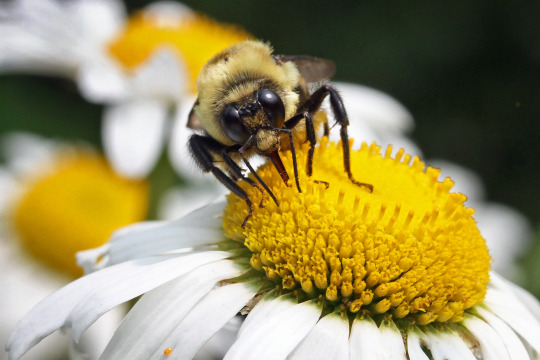
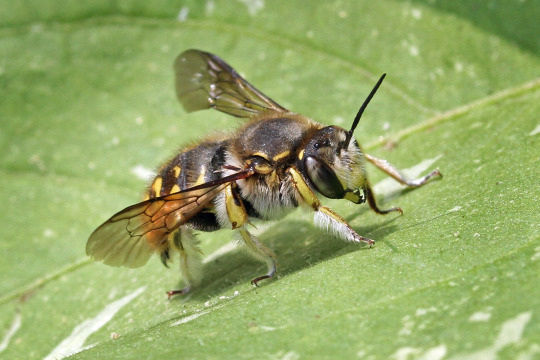
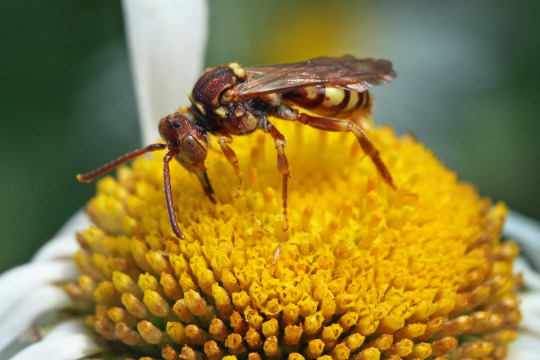
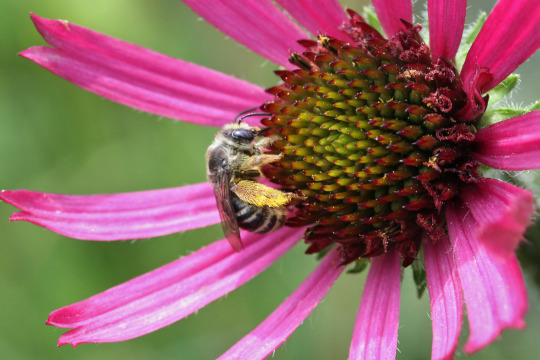
Went to a well-known public garden and found lots of wildlife on the flowers.
Bicolored Striped Sweat Bee (Agapostemon virescens)
Brown-Belted Bumblebee (Bombus griseocollis)
European Wool Carder Bee (Anthidium manicatum)
Nomad Bee (Nomada sp.)
Longhorn Bee (Melissodes sp.)
June 15, 2023
Southeastern Pennsylvania
201 notes
·
View notes
Note
Buzz buzz Trick or Treat!
trick or treat trick or treat! Anthidium manicatum, or the european wool carder bee, is one of my favorite kinds of bee! I love how they clip hairs off of plants (think fuzzy ones like lamb’s ear), roll them up, and use them to line their nests!!
here's a video of one doing her thing!
youtube
3 notes
·
View notes
Text
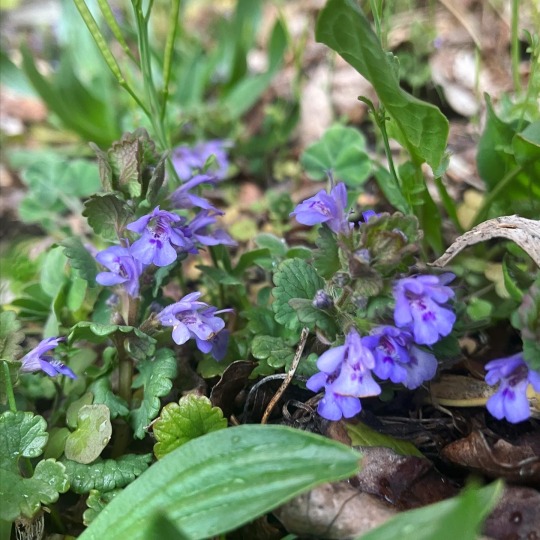
Glechoma hederacea
🌿Glechoma hederacea
Family: Lamiacea (Mint)
Common Names: Ground Ivy, Creeping Charlie, & gill-over-the-ground
Perennial herbaceous plant
Native to Europe, and introduced to North America as early as the 1800's. It is considered Invasive in the U.S as it forms dense patches that can push out native plants.
Pollinators include: Anthophora furcata (Fork-tailed flower bee) Anthidum manicatum (European wool carder bee)
Anthophora plumipes (Hairy-footed flower bee)
Anthophora quadrimaculata (Four-branded flower bee)
Anthophora abrupta (Minor bee)
Osmia aurulenta (Gold-fringed mason bee)
Osmia caerulescens (Blue mason bee)
Osmia lignaria (Blue orchard bee)
#botany#horticulture#botanical#flowers#purple flowers#wildflowers#springtime#invasive species#invasive plants#gardening#plants#the more you know#the more you learn#science rules#creeping charlie#kill your lawn#let them pollinate#flowers for the bees#save the bees#let the bees feed#perennial grasses
8 notes
·
View notes
Text
Red Bistort with western honeybees - a short video of a few of our daily visitors. Haven't counted the bees but we have bumblebees, honeybees, wool carder bees, mason bees (not this late in the season), sweat bees... as well as wasps and hornets and so much more. 🌞
Much better than just grass.
youtube
2 notes
·
View notes
Note
what are Tawnytrot's kits names + genders?
WoolcarderKit (Molly, after the European wool carder bee)
AshyKit (Molly, after the ashy mining bee)
Everyone in tawny’s bio family line is named after bees (tawny mining bee for tawnytrot, hornets for, well, HornetLeg)!
4 notes
·
View notes
Text
So, we recently had to get the backyard landscaped, and I knew it wasn't gonna be a pretty process, but I was not prepared for just how 'violent' it was?? Especially the vinegar treatment on the lawn... jeez. The dudes who did it said it wouldn't affect the couple of trees we have, but it absolutely did. :/
Anyways, it's done now and the only good thing about it is that we're using less water since the veggie garden and one of the border gardens was taken out, however that's cut the biodiversity down to just flies, yellowjackets, and bald-faced hornets. Butterflies, dragon/damselflies, moths, beetles, bees and other wasp species don't stick around for long, and there hasn't been any crane flies or the usual garden spiders either.
It feels like a deadzone and it's actually really depressing! I'm not the most fond of bugs crawling on me or buzzing to close to my ears, but I've always enjoyed watching all these different species go about their business, and interact with each other.
However, the veggie garden was a lot of work to water and maintain, and my family is aging and I'm not doing so hot myself.
I do have an idea, though! We used to have some anise hyssop accidentally growing out of the ground by the deck stairs and that plant attracted everything! Bumble, honey, wool carder bees, skippers, sulphurs, small moths, various wasps, so on and so forth. I can't manage a garden, but I can definitely manage a couple pots of that, so I think it's worth a try!
1 note
·
View note
Note
Seven! What’s your favorite kind of bee and why? You seem like a type to enjoy bumble bee but I might be wrong!
I do enjoy bumblebees, though they are at a tie with wool carder bees! I like the latter because they make their nests out of fluffy plant fibers, which I find rather adorable :)
2 notes
·
View notes